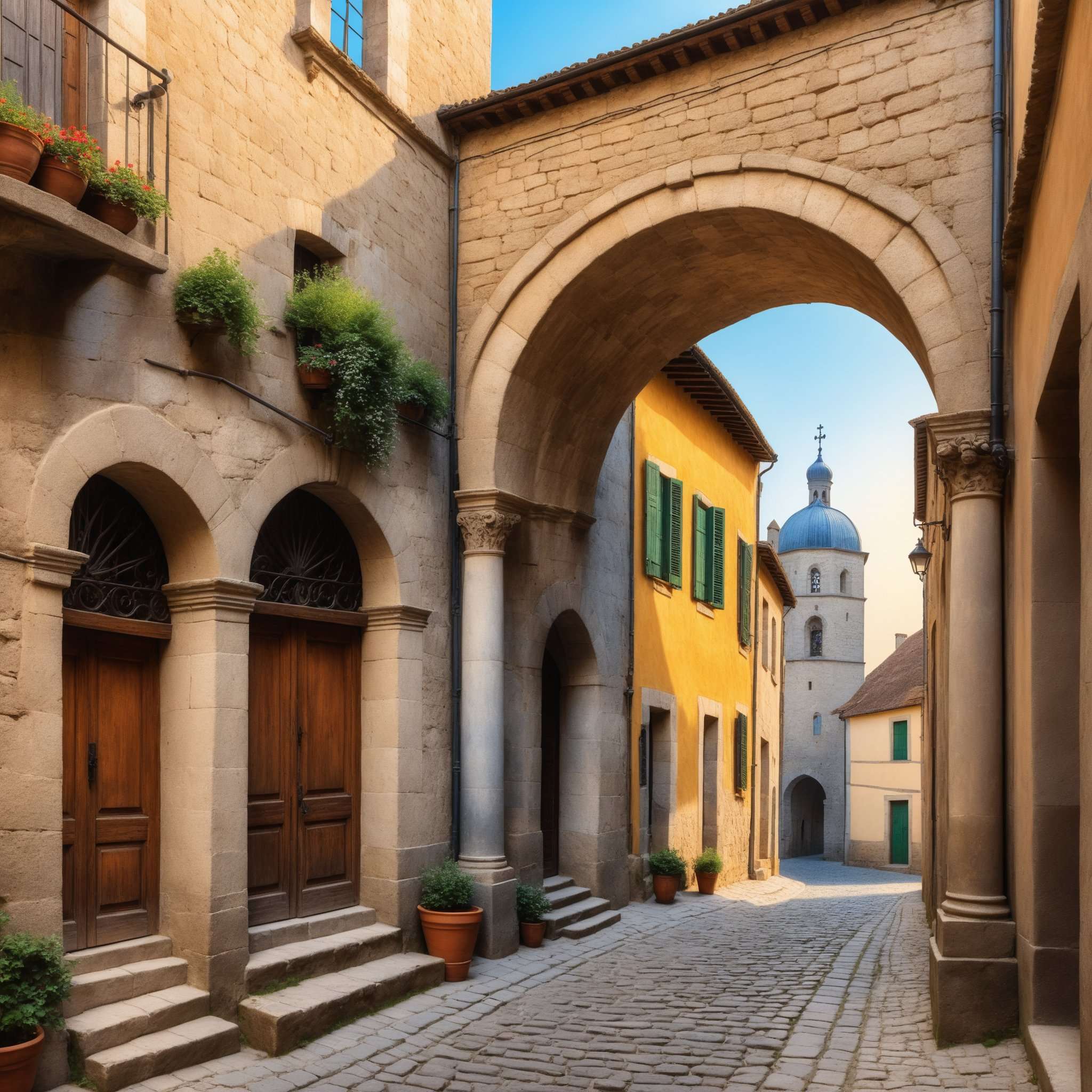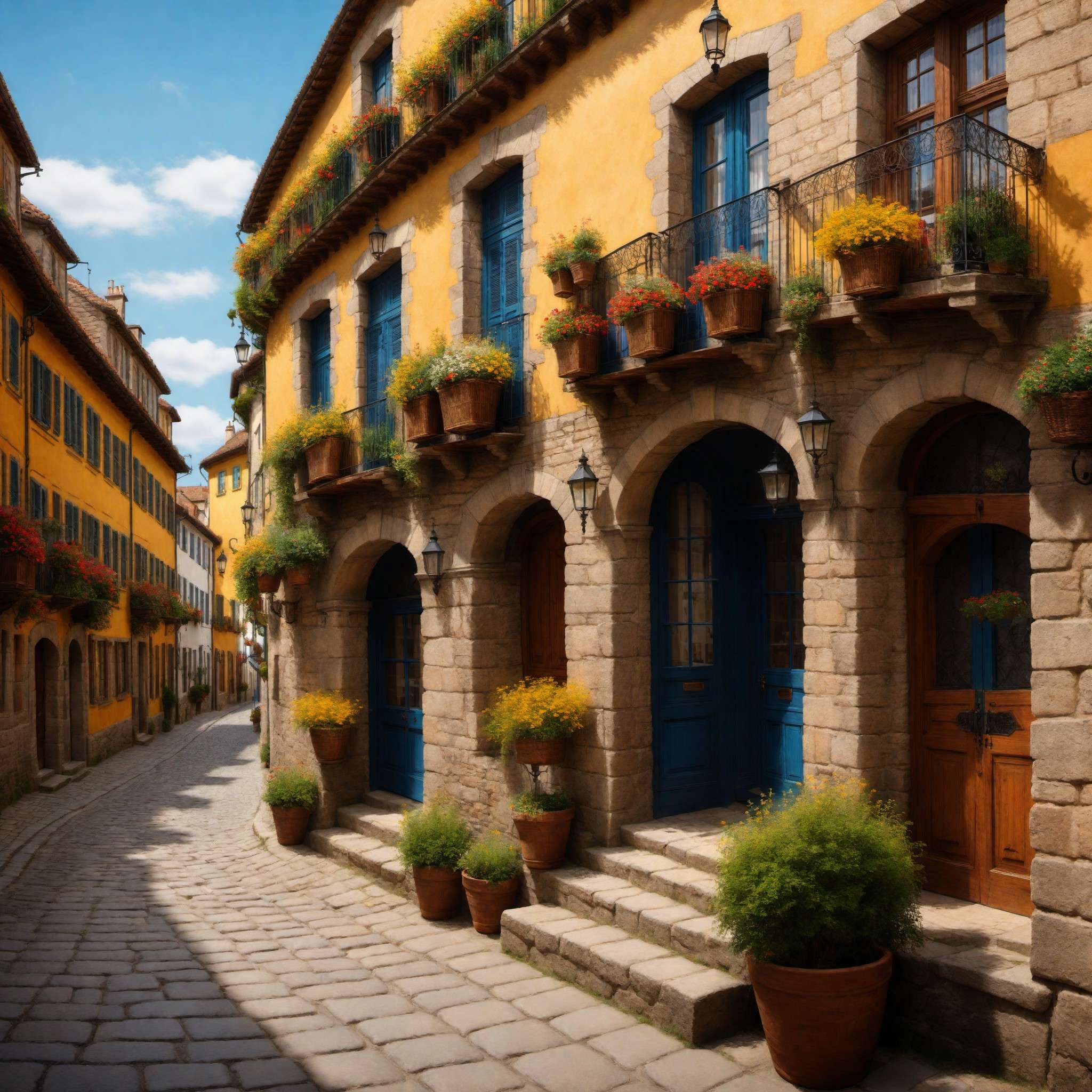Zombie Bunny is Reader-supported and may earn an affiliate commission through links on our site.

10 Unmissable Historical Sites in Europe You Didn’t Know Existed!
Uncover Europe's best kept secrets! Embark on a journey through time with these 10 lesser-known yet utterly captivating historical sites. #TravelEurope #HistoricalSites
Venture off the beaten path and dive into Europe’s rich history with our exploration of the continent’s lesser-known historical sites. From the ancient city of Butrint in Albania and the prehistoric Naveta d’Es Tudons in Spain, to the medieval charm of Visby in Sweden, each site offers a unique narrative that adds depth to our understanding of Europe’s diverse heritage. These hidden gems not only provide an enriching travel experience but also contribute to the preservation of these significant sites. Embark on this journey through time, unearthing Europe’s captivating tales hidden in plain sight.
Introduction: Unearthing Europe’s Hidden Historical Gems

© Copyright , ZombieBunny.Org
Purpose and significance of exploring hidden historical sites
Exploring hidden historical sites serves a dual purpose: it not only quenches the thirst for adventure but also deepens our understanding of the past. These uncharted treasures allow us to step into a world that once was, offering a tangible connection to our ancestry. When we visit less traveled historical sites, we contribute to their preservation and recognition, ensuring that their stories continue to resonate.
Hidden historical sites often harbor unique narratives that mainstream tourist spots may overlook. These gems offer a refreshing perspective on Europe’s rich and diverse history. Every stone, every carving, every monument whispers tales of time, waiting to be discovered. By seeking out these unmissable sites, we’re not just sightseeing; we’re time traveling, experiencing the thrill of discovery, and absorbing history in its purest form. The significance of this exploration extends beyond tourism; it’s about celebrating our shared human heritage.
Brief overview of Europe’s rich history
Europe’s history is a captivating tapestry woven over millennia. From the ancient civilizations of Greece and Rome, through the Middle Ages, Renaissance, and up to contemporary times, Europe has been the theater of profound cultural, political, and technological transformations. Its rich heritage is reflected in its diverse architecture, art, and traditions that span across the continent.
The beauty of Europe’s history lies in its diversity. Every region, every country, every city has a unique story to tell. Ancient ruins, medieval castles, and Renaissance palaces stand as enduring symbols of Europe’s past. Less known historical sites are like hidden chapters of this grand narrative, often overshadowed by their famous counterparts but equally significant. They serve as reminders of Europe’s multifaceted past, offering a deeper, more comprehensive understanding of the continent’s historical journey. Exploring these sites is akin to flipping through the pages of a living history book, where each destination offers a new chapter to discover.
What makes a historical site ‘unmissable’
An ‘unmissable’ historical site is one that transcends the ordinary, offering a unique blend of history, culture, and beauty. These are the places that make us pause, reflect, and feel connected to the narrative of our past. They offer something beyond the typical tourist experience, providing a deeper, more enriching journey into history.
A historical site becomes unmissable when it offers an authentic experience. Whether it’s an ancient monument shrouded in mystery, a castle that’s witnessed centuries of change, or a cultural landmark that encapsulates the spirit of a bygone era, these places captivate us with their stories. They offer a glimpse into the past that is both educational and awe-inspiring. Exploring these sites enriches our understanding and appreciation of history. It’s not just about ticking off boxes on a tourist checklist; it’s about immersing yourself in the past, strolling through history’s corridors, and experiencing the indelible mark each era has left on the world.
Under the Radar Ancient Monuments

© Copyright , ZombieBunny.Org
The ancient city of Butrint, Albania
Tucked away in the lush greenery of southern Albania lies the ancient city of Butrint, a UNESCO World Heritage Site. This archaeological wonder, with its origins dating back to the Bronze Age, offers a diverse tapestry of European history. From Greek colonists, Roman conquerors, Byzantine bishops, to Venetian fortifications, Butrint has stood the test of time.
Its ruins tell a compelling story of civilizations past. The Greek amphitheater, once buzzing with theatrical performances and gladiator fights, now stands in silent majesty. The Roman forum, the public heart of the city, whispers tales of political discourse and societal norms. The Byzantine basilica, a symbol of spiritual life, still retains a sense of divine tranquility. Butrint is more than just ruins; it’s a historical narrative waiting to be discovered. Its relative obscurity makes it an unmissable site for those seeking to delve deeper into Europe’s rich and diverse past.
The Naveta d’Es Tudons, Menorca, Spain
Nestled on the tranquil island of Menorca, Spain, the Naveta d’Es Tudons stands as a testament to the region’s prehistoric past. This remarkable stone structure, dating back to 1000-800 BC, is considered one of the oldest fully preserved buildings in Europe. Its name, derived from the Catalan word for ‘ship’, aptly describes its unique, inverted hull-like shape.
This Bronze Age monument was a collective burial site, housing the remains of at least 100 individuals, along with personal artifacts and offerings. The structure’s architectural precision, with its meticulously layered stones and secure interlocking system, highlights the advanced construction skills of the early inhabitants of the island. The Naveta d’Es Tudons offers a rare glimpse into the spiritual beliefs, societal practices, and architectural prowess of a civilization long past. Its historical significance and architectural intrigue make it an unmissable site for any history-loving traveler seeking a unique European adventure.
The Bronze Age settlement of Arkaim, Russia
The Bronze Age settlement of Arkaim, located in the steppes of the Southern Ural region in Russia, is often referred to as ‘Russia’s Stonehenge’. Discovered in the 20th century, this archaeological site dates back to the 17th century BC and offers a fascinating glimpse into early urban life.
Arkaim’s circular design, precise astronomic alignments, and sophisticated drainage system highlight the advanced engineering skills of its builders. It’s believed to have been a significant cultural, economic, and spiritual center for the ancient Indo-European population. The site’s unique layout suggests it may have served as an astronomical observatory, with structures aligned to track the movements of the sun, moon, and certain stars.
Arkaim’s historical and astronomical significance, coupled with the mystery surrounding its inhabitants’ sudden departure, make it an unmissable destination. For those seeking to unearth Europe’s lesser-known historical gems, the journey to Arkaim promises a rich and rewarding experience.
Castles and Fortresses Hidden in Plain Sight

© Copyright , ZombieBunny.Org
Burg Eltz Castle, Germany
Nestled in the hills above the Moselle River between Koblenz and Trier, Germany, sits the enchanting Burg Eltz Castle. This medieval wonder, still owned by the Eltz family who built it in the 12th century, evokes a fairytale-like charm. Unlike many castles that have weathered wars and sieges, Burg Eltz has remained intact, offering an authentic glimpse into the medieval era.
The castle’s architectural beauty, with its eight towering turrets, timber-framed structures, and intricate interior designs, is a testament to the craftsmanship of the Middle Ages. Inside, an impressive collection of original furnishings, armors, and artworks span centuries of history. The castle’s picturesque setting amidst the dense forest, atop a 70-meter-high rock, adds to its allure.
Burg Eltz Castle’s unspoiled beauty, historical integrity, and family lineage make it an unmissable historical site. A visit here is a journey back in time, offering a captivating experience of Europe’s medieval heritage.
Spiš Castle, Slovakia
Perched atop a hill overlooking the Spiš region of Slovakia, the Spiš Castle is one of the largest castle complexes in Central Europe. Dating back to the 12th century, this imposing fortress, now a UNESCO World Heritage Site, dominates the landscape with its expansive ruins and majestic presence.
The castle’s history is as vast as its grounds, having been a political, economic, and cultural center for various kingdoms and empires. Its architectural evolution from Romanesque beginnings to Gothic modifications is evident in its walls, offering a visual timeline of architectural trends. The castle’s strategic location provided a panoramic view of the surrounding lands, offering both defense and dominance.
Today, the Spiš Castle stands as a symbol of Slovakia’s rich history. Its imposing ruins, panoramic views, and historical importance make it an unmissable site for history enthusiasts and travelers alike. Exploring its ruins is like traversing the chapters of Europe’s fascinating past.
Château de Saumur, France
Overlooking the Loire River in the heart of France, the Château de Saumur is a gem often overlooked by those visiting the country’s more famous castles. This majestic fortress, originally built in the 10th century as a stronghold against Norman attacks, later transformed into a palatial residence in the 14th century, embodying the elegance of French Gothic architecture.
The Château de Saumur, with its turreted towers, ornamental chimneys, and intricate stonework, depicts a picturesque image of medieval grandeur. Its interior houses several museums, showcasing equestrian art, decorative arts, and a remarkable collection of figurines, providing insight into the region’s cultural heritage.
Despite its turbulent history, including a near-collapse and subsequent restoration, the Château de Saumur remains a symbol of France’s historical and architectural wealth. Its stunning architecture, coupled with its rich history and impressive views over the Loire Valley, make it an unmissable historical site in Europe.
Unexplored Cultural and Historical Landmarks

© Copyright , ZombieBunny.Org
Rila Monastery, Bulgaria
Nestled in the heart of the Rila Mountains in Bulgaria, the Rila Monastery is a beacon of Bulgarian identity. Founded in the 10th century by St. John of Rila, Bulgaria’s patron saint, this fortress-like complex is the largest and most famous Eastern Orthodox monastery in the country.
The Rila Monastery is renowned for its unique blend of Byzantine, Bulgarian, and Arab architectural influences. Its stunning frescoes, intricate wood carvings, and the towering main church are a testament to Bulgaria’s rich cultural and spiritual heritage. A significant cultural, historical, and architectural monument, the monastery has been a spiritual center for Bulgarian Orthodox faith for centuries.
Bathed in tranquility and steeped in history, the Rila Monastery offers a unique spiritual journey to its visitors. Its unspoiled beauty, historical significance, and spiritual aura make it an unmissable cultural and historical landmark in Europe.
The Trulli of Alberobello, Italy
In the heart of Italy’s Puglia region lies the town of Alberobello, famous for its ‘Trulli’. These unique, whitewashed limestone dwellings with conical roofs are a charming testament to a traditional building technique specific to this region. The Trulli of Alberobello, a UNESCO World Heritage site, offer a unique glimpse into Italy’s architectural past.
These quaint, dry-stone structures, built without mortar, exhibit an ancient form of construction that’s both practical and enchanting. The thick walls keep the interiors cool in summer and warm in winter, while the conical roofs are adorned with symbolic markings. The town’s narrow streets, flanked by Trulli, transport visitors into a fairytale-like setting.
The Trulli of Alberobello represent a significant cultural tradition, embodying a unique architectural style that has been preserved over centuries. This unmissable site offers a fascinating journey into Italy’s cultural heritage, standing as a testament to the country’s rich architectural history.
The Medieval Town of Visby, Sweden
The medieval town of Visby, located on the island of Gotland, Sweden, is a captivating journey back in time. Known as the ‘Pearl of the Baltic’, Visby, a UNESCO World Heritage Site, is one of the best-preserved medieval cities in Scandinavia. Its charming cobblestone streets, picturesque cottages, and impressive stone wall encapsulate a rich historical tapestry.
Remnants of Visby’s past as a thriving Hanseatic trading port are evident in its well-preserved merchants’ houses, warehouses, and churches. The city’s 13th-century ring wall, punctuated by towers and gates, stands as a monument to Visby’s historical significance. The annual Medieval Week, with its tournaments, markets, and parades, brings the city’s history to life.
Visby’s charm lies in its ability to blend the past with the present seamlessly. Its preserved medieval architecture, rich history, and vibrant cultural scene make it an unmissable historical site for those exploring Europe’s hidden gems.
Conclusion: Embrace the Unknown History of Europe

© Copyright , ZombieBunny.Org
Recap of the historical sites explored
From the ancient city of Butrint in Albania that paints a vivid picture of Europe’s antiquity, to the Naveta d’Es Tudons in Spain whispering stories of prehistoric life, our journey has traversed the timeline of European history. We’ve explored the grandeur of castles like Germany’s Burg Eltz and Slovakia’s Spiš Castle, and ventured into the mystical Bronze Age settlement of Arkaim in Russia.
Our cultural exploration led us to the spiritual haven of Rila Monastery in Bulgaria, through the unique Trulli of Alberobello in Italy, and into the medieval charm of Visby in Sweden. Each of these sites is a testament to Europe’s diverse heritage, offering a unique lens through which to view the continent’s past. These unmissable historical sites serve as tangible links to our shared history, each with its unique narrative waiting to be discovered and appreciated.
The importance of visiting lesser-known historical sites
Visiting lesser-known historical sites can offer a far more enriching experience than sticking to the well-trodden path. These hidden gems allow us to delve deeper into the cultural and historical fabric of a destination, offering insights that often escape the mainstream tourist gaze. They provide a more intimate understanding of a region’s past, its people, and its evolution.
By stepping off the beaten track, we contribute to the preservation and appreciation of these sites. Our interest can spark further research and conservation efforts, ensuring these places continue to tell their stories for generations to come. Furthermore, visiting these lesser-known sites often supports local economies, promoting sustainable tourism. These uncharted historical treasures are not just sites; they are narratives of our shared human heritage. By exploring them, we become part of their story, enriching our own understanding of the world and its history.
Encouragement for readers to embark on their own exploration
Embracing the unknown and embarking on your own exploration of these lesser-known historical sites is more than just a journey; it’s an enriching experience that extends beyond the realms of conventional tourism. It’s about immersing yourself in the past, experiencing history firsthand, and appreciating the diverse cultural tapestry that Europe offers.
Remember, every corner turned, every stone unturned, every monument visited adds a new layer to your understanding of our shared history. As you explore these sites, you’ll find yourself not just a spectator, but an active participant in the grand narrative of human civilization.
So, pack your bags, lace up your boots, and let your curiosity guide you. Venture beyond the tourist trails, seek out the unexplored, and discover the stories that lie hidden in Europe’s landscape. The journey to uncover Europe’s unmissable historical sites awaits you. Embrace the adventure, and let history unfold before your eyes.
Please support our site and purchase something from our store.







